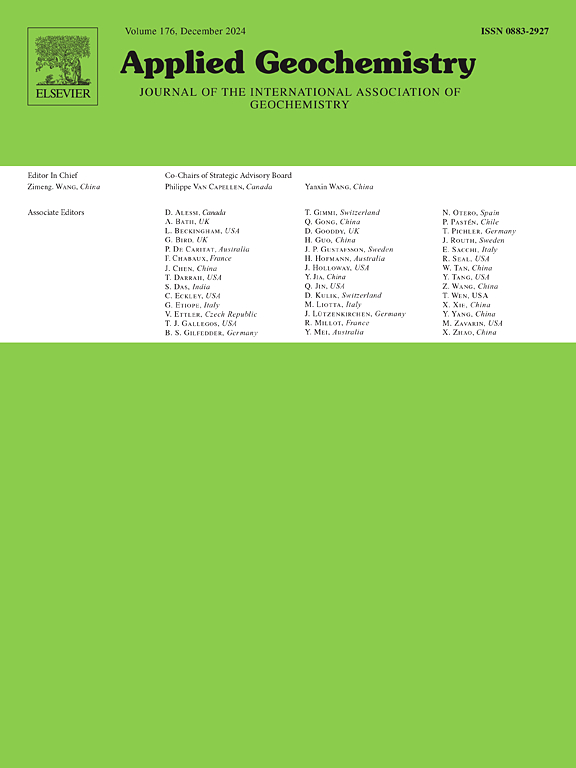Electrochemical migration-induced mineral reactions at the bentonite-concrete interface in multi-barrier systems
IF 3.4
3区 地球科学
Q1 GEOCHEMISTRY & GEOPHYSICS
引用次数: 0
Abstract
This study investigates the effect of electrochemical migration on the geochemical stability of multi-barrier nuclear waste repositories. We used a multicomponent reactive transport modeling approach to conduct two simulations: one considering only Fickian diffusion (FD) and another incorporating both Fickian diffusion and electrochemical migration using the Nernst-Planck equation (NP). The model domain consisted of bentonite, concrete, and granite barriers. The NP simulation results revealed Ca2+ fluxes moving against their concentration gradients across the bentonite-concrete interface (BCI), driven by Coulombic interactions. This uphill diffusion of Ca2+ is coupled with the downhill diffusion of SO42−, resulting in the concurrent migration of both ions from bentonite to concrete. This process triggers slow gypsum dissolution and precipitation near the BCI, even though local equilibrium with respect to gypsum was reached. These unexpected mineral reactions across the BCI persist even after gypsum is completely depleted in the bentonite near the interfaces, as long as the pore connection near the BCI is maintained. Our findings highlight the significance of electrochemical effects for the long-term stability of multi-barrier systems in nuclear waste repositories.
多势垒体系中膨润土-混凝土界面上电化学迁移诱导的矿物反应
研究了电化学迁移对多屏障核废料储存库地球化学稳定性的影响。我们使用多组分反应输运建模方法进行了两种模拟:一种只考虑菲克扩散(FD),另一种使用能思-普朗克方程(NP)同时考虑菲克扩散和电化学迁移。模型区域由膨润土、混凝土和花岗岩屏障组成。NP模拟结果显示,在库仑相互作用的驱动下,Ca2+通量沿着膨润土-混凝土界面(BCI)的浓度梯度移动。Ca2+的上坡扩散与SO42−的下坡扩散相结合,导致两种离子从膨润土同时迁移到混凝土中。这个过程触发了缓慢的石膏溶解和沉淀在BCI附近,即使石膏达到了局部平衡。即使在界面附近的膨润土中的石膏完全耗尽后,只要保持BCI附近的孔隙连接,这些意想不到的矿物反应仍会在BCI上持续存在。我们的研究结果强调了电化学效应对核废料储存库中多屏障系统长期稳定性的重要性。
本文章由计算机程序翻译,如有差异,请以英文原文为准。
求助全文
约1分钟内获得全文
求助全文
来源期刊

Applied Geochemistry
地学-地球化学与地球物理
CiteScore
6.10
自引率
8.80%
发文量
272
审稿时长
65 days
期刊介绍:
Applied Geochemistry is an international journal devoted to publication of original research papers, rapid research communications and selected review papers in geochemistry and urban geochemistry which have some practical application to an aspect of human endeavour, such as the preservation of the environment, health, waste disposal and the search for resources. Papers on applications of inorganic, organic and isotope geochemistry and geochemical processes are therefore welcome provided they meet the main criterion. Spatial and temporal monitoring case studies are only of interest to our international readership if they present new ideas of broad application.
Topics covered include: (1) Environmental geochemistry (including natural and anthropogenic aspects, and protection and remediation strategies); (2) Hydrogeochemistry (surface and groundwater); (3) Medical (urban) geochemistry; (4) The search for energy resources (in particular unconventional oil and gas or emerging metal resources); (5) Energy exploitation (in particular geothermal energy and CCS); (6) Upgrading of energy and mineral resources where there is a direct geochemical application; and (7) Waste disposal, including nuclear waste disposal.
 求助内容:
求助内容: 应助结果提醒方式:
应助结果提醒方式:


